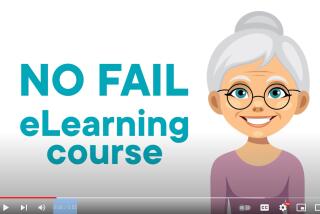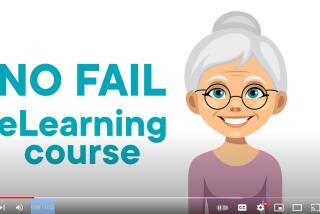DMV at Last Catching Up on Backlog
- Share via
SACRAMENTO — When Gov. Arnold Schwarzenegger tried two months ago to simply give California drivers some of their tax money back, it had the unintended effect of temporarily bringing a state agency to a standstill.
Only now are Department of Motor Vehicles managers confident that they are gaining on a backlog of hundreds of thousands of license tag renewals -- a logjam that had some motorists afraid they would be cited for driving with expired stickers.
As soon as he took office Nov. 17, Schwarzenegger made good on a campaign promise and abolished $4 billion worth of increases in vehicle license fees that former Gov. Gray Davis had imposed to help balance the state budget.
The rollback affected car license renewals and vehicle registrations as of Oct. 1.
But as wildly popular as the repeal was with motorists and car dealers, it also was the final ingredient for a bureaucratic storm that had been building for two years. As a result:
* Department computers were deliberately shut down for several days after they were overwhelmed by requests from Californians eager to pay less to renew their registrations;
* Police departments were asked not to ticket motorists who had paid their fees in November and December but had not received new tags before the old ones expired;
* And the department was unable to say when 4.5 million drivers who had paid the higher rate would receive their share of $600 million in refunds due at the start of 2004.
In an interview last week, Chon Gutierrez, the DMV’s new interim director, said he expected the renewal backlog to be eliminated in the next week or so. In some cases, drivers have waited five and six weeks for new tags.
Gutierrez also said refunds were “very, very close” to being delivered. But, reflecting the caution acquired during 30 years in state government, he would not specify a date.
For an 8,000-member department familiar with criticism and controversy, the DMV’s business of delivering on Schwarzenegger’s repeal of fees tested both the patience of drivers and the agency’s ability to change course quickly.
The task, Gutierrez said, may even have dwarfed his previous toughest assignment: launching the California Lottery in 1985.
For starters, the department was handicapped by the loss of more than 400 employees because of two years of budget cuts under Davis. Second, a hiring freeze prohibited replacing them. Third, a backlog of registrations had begun to build.
As soon as Schwarzenegger rolled back the license fees, hundreds of thousands of motorists who had received invoices at the old rate eagerly applied for the new rates, many recalculating their own payments and sending in handwritten returns.
But within a week, the DMV’s payment-processing equipment got so overwhelmed that harried officials switched it off for several days while figuring out ways to help the computers cope. That delay aggravated an existing backlog of sticker renewals.
By Dec. 8, DMV officials began appealing to every police and sheriff’s department in the state to go easy on motorists whose tags had expired during November and December and not to cite them until at least Jan. 31.
California Highway Patrol Commissioner D.O. “Spike” Helmick went even further, instructing his officers not to cite motorists until 90 days after the expiration of a November or December tag.
Normally, the CHP observes a 30-day grace period.
“We told our officers to be very understanding when they stop somebody,” said CHP spokesman Tom Marshall.
Renewals due this month and beyond won’t suffer the same delays, because they were initiated after the November license fee repeal.
At the DMV, the registration backlog had become chronic even before Schwarzenegger repealed the fee increase. In October 2001, it took an average of 8 1/2 days to process the paperwork and get a sticker into the mail, officials said. At that time, 75,000 registration payments arrived each day.
By early last November, the delay had stretched to an average of 21 days, they said. A few days before Schwarzenegger took office, Steve Gurley, then the DMV director, urged motorists to avoid visiting DMV field offices on registration matters, because “we just don’t have enough people to handle routine business.” He suggested they register by mail or online.
Soon after Schwarzenegger signed the repeal order, the mailbags started arriving with 82,000 registration returns each day. Processing time almost doubled to 38 days, a department spokesman said.
In car-compulsive California, the department issues 2.5 million registration renewal invoices each month, or about 30 million a year, by far the most of any state.
Because the billings are sent 60 days in advance, about 8.5 million invoices had been mailed by the time the fee increases were repealed.
Two days after Schwarzenegger signed the executive order, he appointed Gutierrez and directed him to “take any and all steps necessary” to implement the fee repeal.
Gutierrez and top managers had to figure out how to get refunds to Californians who had overpaid; how to enable others to avoid paying the higher rate by recalculating the amount; and how to issue invoices for January and subsequent months that reflected the correct fees.
“It was triage almost,” Gutierrez said.
One day after the governor’s order, officials announced that motorists who had received invoices at the former rate could recalculate how much was owed and return a lesser sum under the honor system.
But within days, the innovation turned sour.
The rush of handwritten recalculations swamped DMV’s computers.
Officials also faced the issue of permanently converting the registration process to the new, lower rates.
Preliminary estimates indicated the task of reprogramming computers would take 30 to 90 days.
Insisting on faster action, Gutierrez and his deputies ordered the reprogramming to be done on an emergency basis. Working under high pressure around the clock and on weekends, employees finished the project in seven days.
“It captured the imagination of everyone at DMV,” Gutierrez said.
Additionally, a special calculator was added to the DMV’s website -- www.dmv.ca.gov -- to help motorists whose invoices listed the old rate.
More to Read
Get the L.A. Times Politics newsletter
Deeply reported insights into legislation, politics and policy from Sacramento, Washington and beyond. In your inbox twice per week.
You may occasionally receive promotional content from the Los Angeles Times.








